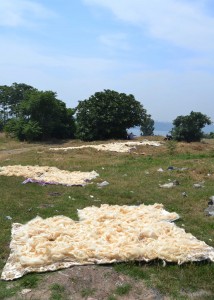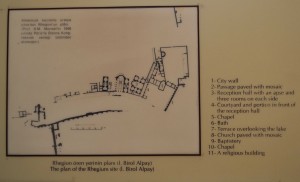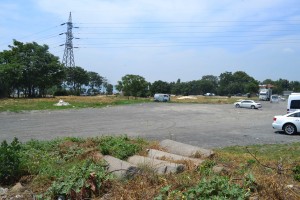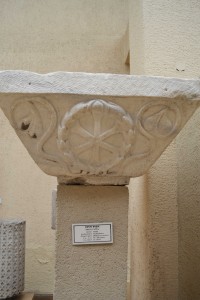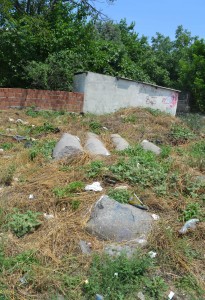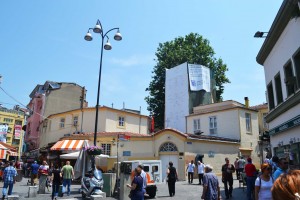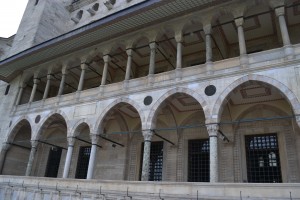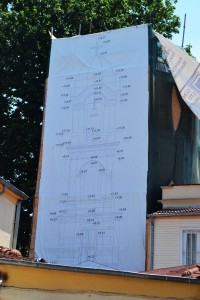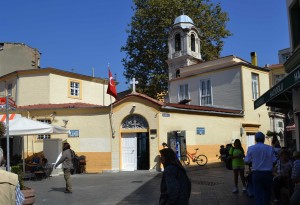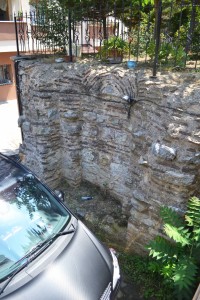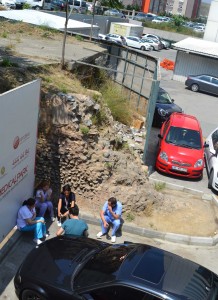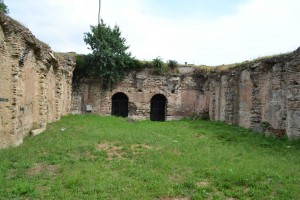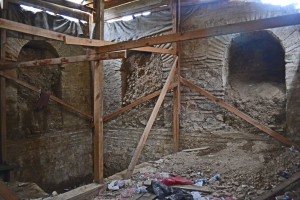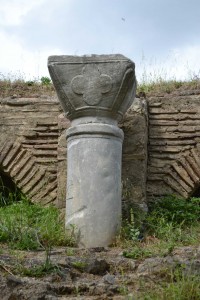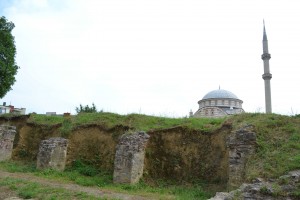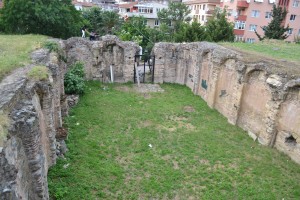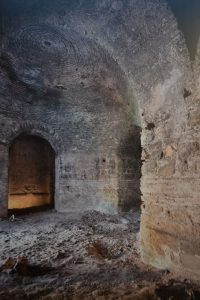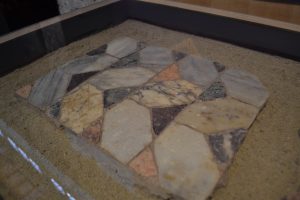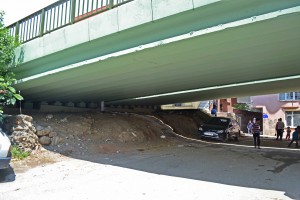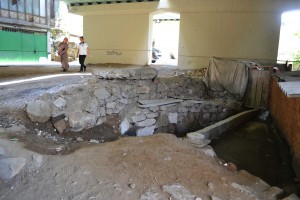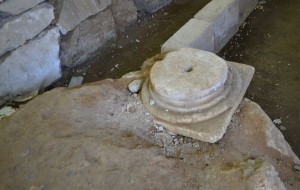The shallow lake to the west of Istanbul has not been seen as a desirable location in the last few decades. However, it used to be a magnet for recreation seekers, including Atatürk. Further back, when the lake provided a nice stop on the Via Egnatia, the road to Constantinople, this was a flourishing town of opulent summerhouses for the rich. Mamboury studied the extensive remains to the south-east of the lake (40.987422,28.777431) and claimed that this was the Byzantine town of Rhegium. Later researchers identify it as Roman Bathonea. The remains are thin on the ground now. Four and a half columns buried by dumped grass mowings. These probably come from one of the churches or chapels that made up a fair proportion of the imperial compound.
Still, when you look from the columns over the field of drying wool to the blue water of the lake, you can get a vague idea of what a good site this was for a palace. Better preserved remains on the relatively uninhabited north-west shore (41.032978,28.734012) have been labelled as part of Rhegium but other researchers call this area Bathonea. Whatever the name, this area has been settled for a long time, as remains associated with Pleistocene hominids in Yarımburgaz Cave (41.074563,28.742815) testify.
- Four and a half columns

Posted June 25, 2014 Posted by Adam in Uncategorized
St Euphemia, an important saint in Orthodox hagiography, was probably the world’s second most famous virgin. She was tortured for her Christianity and, as the final trial of her martyrdom, was thrown to some particularly tolerant lions who merely licked her wounds. A bear, presumably a beast against which the protective power of virginity counted for naught, eventually finished her off.
It is St Euphemia who is to blame for the great split in the Orthodox Church that occurred at the Council of Chalcedon in 451. The Miaphysites and the Dyophysites wrote down their statements of belief and laid them reverently on the breast of the saint in her tomb at Chalcedon. Three days later Euphemia was holding the scroll with the Diaphysite statement in her right hand while the other was at her feet. Since then the Oriental Orthodox community (Armenian, Coptic, Syriac, Ethiopian) pretend that the council did not happen and only recognise the first three Ecumenical Councils.
The church in which the council was held seems to have been destroyed in a Persian invasion in about 626. Euphemia’s remains had apparently been moved to the new Martyrium in Sultanahmet. Whatever church was built to take its place was in a condition of disarray when plundered for columns by Sinan in his quest for building materials for the Süleymaniye. The current church was built in the middle of Kadıköy Market (40.990633,29.024908) in 1694 and has been extensively burnt, damaged, rebuilt and renovated since. The walls are very, very yellow. The company doing the current renovation has provided a handy guide to the dimensions of the tower should the good people at Miniatürk wish to construct a replica.
The tower is once again out of scaffolding and providing a focal point for the life in the Kadıköy community.

Posted June 25, 2014 Posted by Adam in Uncategorized
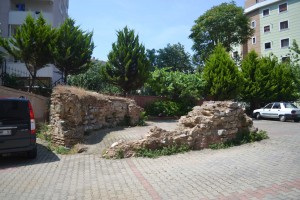
This is a thriving suburb in the Göztepe area. A Byzantine wall in the car park of an apartment block (40.988698,29.077986) has been identified as part of one of the many monasteries in the Diocese of Chalcedon. But these days, it’s just a bit of an obstruction to people trying to park their cars.
At the bottom of the hill, there are substantial bits of a cistern that form part of the car park wall of the new Medical Park Hospital. Staff on their cigarette breaks revel in the Byzantine surroundings.
Posted June 25, 2014 Posted by Adam in Uncategorized
This is a remarkable site (40.943748,29.115137) that has fallen victim to the tendency to establish a project with huge fanfare, then leave it to crumble when the money runs out. It’s still an amazing place. Essentially, the site is a raised platform of about 60m by 40m. The excavated section appears to be bounded by the walls of a collapsed cistern, once consisting of columns supporting rows of domes. The information on site says three rows of domes although it looks like four to me. The part on the east has an impressive single dome which is still standing. On top of this (and resting on the same four piers as supported this eastern dome) was constructed a large church with a dome about ten metres in diameter.
As usual, there is conjecture over the name and function of the building. One faction suggests that the church is part of the Palace of Bryas, built in 834 by the Emperor Theophilus. However, the Italian team that investigated the site in 2002 found evidence that this building is from the second half of the ninth century. It may be the church of the Monastery of Satyros, which was apparently quite close to Bryas Palace. It is doubtful whether the identity of the church will ever be settled.
In the meantime, anyone can get in. It’s a bit difficult to enter the large domed cistern but the rest is fair game. Small children play football against the outside walls and teenagers gather on the high walls after school. Remarkably, graffiti and incidental damage are minimal.
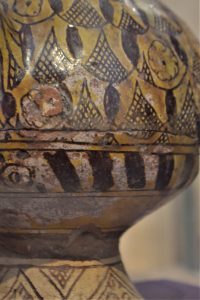
13th – 14th century earthenware pitcher with sgrafitto decoration, from Küçükyalı. Istanbul Archaeological Museum.
No Author listed. (2002) Maltepe’deki arkeolojik kazıdan kilise mi saray mı tartışması çıktı. Arkitera Bilgi Hizmetleri Available online at: http://v3.arkitera.com/v1/haberler/2004/12/30/maltepe.htm Accessed 10th Aug 2016
Kayar, A. (2005) Bizans prensinin manastırı Türkiye’nin ilk arkeolojik parkı olacak Hürriyet. Available online at: http://www.hurriyet.com.tr/bizans-prensinin-
manastiri-turkiye-nin-ilk-arkeolojik-parki-olacak-342077 Accessed 10th Aug 2016
Ricci, A. (1996) The Road from Baghdad to Byzantium and the Case of the Bryas Palace. In Brubaker, L. (ed) Byzantium in the Ninth Century: Dead or Alive? Papers from the Thirtieth Spring Symposium of Byzantine Studies, Birmingham, March 1996. Ashgate – Variorum, Aldershot. Pages 131 – 149. Available online at: https://www.academia.edu/1164332/A._Ricci_The_Road_from_Baghdad_to_Byzantium_and_the_case_of_the_Bryas_Palace Accessed 2nd Aug 2016

Posted June 25, 2014 Posted by Adam in Uncategorized
The TAY website is dedicated to recording the destruction of Turkey’s archaeological treasures and makes melancholy reading. One of its less cheery articles concerns the stonework in Pendik which was investigated in 1973-75, identified as a Byzantine monastery and promptly buried beneath a new road bridge. Not a lot here now (40.891269,29.238836). When that column base disappears, it will just be a pile of rubble.

« Previous Entries Next Entries »
